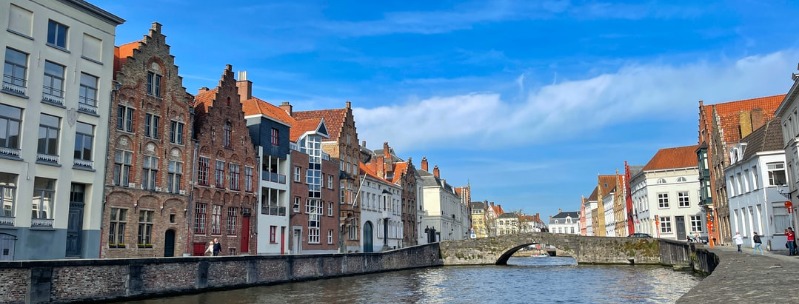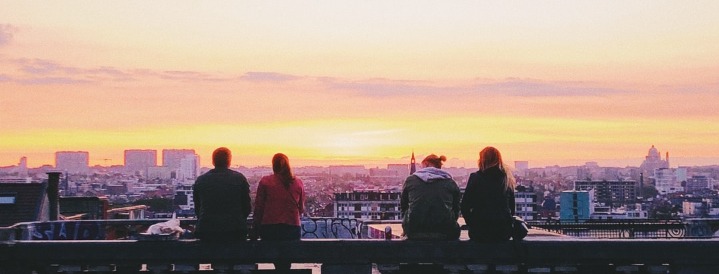Vacation in Belgium
Belgium is quintessential Europe in many ways, being small, beautiful, and sandwiched between popular European vacation destinations. A fusion of Flemish and French language and culture. The European Union’s capital. Canals, complex architecture, and medieval streets abound. A small, easily navigable country where beer, pastries, and chocolate are plentiful – and arguably better than elsewhere in Europe. All of this can be experienced during a vacation in Belgium.
A federal country, with three official languages and an intense regional rivalry, Belgium has a cultural diversity that belies its rather dull reputation among travelers. Its population of around ten million is divided between Flemish speakers (about sixty percent) and French-speaking Walloons (forty percent), with a few pockets of German speakers in the east.
Prosperity has shifted back and forth between the two communities over the centuries, and relations remain acrimonious. The constitution was redrawn in 1980 on a federal basis, with three separate entities: the Flemish North, Walloon South, and Brussels, which is officially bilingual (although its population is eighty percent French-speaking).
The north and south of Belgium are visually very different. Marking the meeting of the two, Brussels , the capital is a culturally varied city at the heart of the European Union.
The north, made up of the provinces of West and East Flanders, Antwerp, Limburg and much of Brabant, is mainly flat, with a landscape and architecture not unlike Holland. Antwerp is the second city, a bustling old port with doses of high art, redolent of its sixteenth-century golden age. Further south and west are the great historic cities, Bruges and Ghent , with a stunning concentration of Flemish art and architecture. Another enjoyable inland Flanders town is the cathedral city of Mechelen , halfway between Brussels and Antwerp. The southern reaches of Brabant are French-speaking and merge into the Walloon province of Hainaut – rich agricultural country, scarred by pockets of industry and boasting the historic city of Tournai. East of here lies Belgium’s most scenically rewarding region, the Ardennes , an area of deep, wooded valleys, high elevations and dark caverns.
The Ardennes reach across the border into the northern part of the Grand Duchy of Luxembourg , a verdant landscape of rushing rivers and high hills topped with crumbling castles. Diekirch , Vianden, and Echternach are perhaps the three best centers for touring the countryside, and Luxembourg City itself is at least worth a stop, although its population of around 80,000 is tiny by capital-city standards.
Best of Belgium
The Ardennes
There’s a popular conception that all of Belgium is pancake-flat – but it isn’t true. The southern part of the country holds the forested hills and river valleys of the Ardennes, popular with canoeists and hikers alike.
Belgian Chocolate
Often imitated but never bettered, Belgian chocolate is internationally famous: Leonidas is probably the cheapest chain, but many people prefer the chocolates of the smaller Neuhaus company. Every large town has at least a couple of chocolate shops.
Groeninge Museum
In Bruges, the Groeninge Museum has one of Europe’s most magnificent collections of Flemish medieval paintings, from the delicacy of works by Jan van Eyck to the bloodthirsty allegories of Gerard David.
Tournai
Often neglected by British tourists, Tournai’s antique town center, with its narrow lanes and cobbled alleys, fans out from an imposing Romanesque Cathedral, decorated with extraordinary carvings of the Virtues and the Vices.
Musées Royaux des Beaux-Arts
In Brussels, the Musées Royaux des Beaux-Arts constitute Belgium’s most satisfying collection of fine art, with stunning samples of the work of Pieter Bruegel the Elder, Rubens and the Belgian surrealists – most notably Magritte and Delvaux.
Centre Belge de la Bande Dessinée
Catch up on Hergé’s Adventures of Tintin in Brussels at the Centre Belge de la Bande Dessinée, which is devoted to the fascinating history of the country’s cartoons and comic strips.
Adoration of the Mystic Lamb
Of the hundreds of exquisite medieval paintings on view in Belgium, perhaps the most wonderful is the Adoration of the Mystic Lamb, a stunning and extraordinarily intricate painting displayed in St Baafskathedraal in Ghent.
Onze Lieve Vrouwe Cathedral
If you’re heading for Antwerp, you must visit the Onze Lieve Vrouwe Cathedral and admire the three Rubens paintings hanging inside, as well as the fine sixteenth-century interior.
Getting to Belgium
Trains
- Antwerp to: Bruges (hourly; 1hr 20min); Ghent (every 30min; 50min).
- Bruges to: Ostend (every 20min; 15min); Zeebrugge (hourly; 15min).
- Brussels to: Antwerp (every 30min; 40min); Bruges (every 30min; 1hr); Ghent (every 30min; 40min); Luxembourg (every 2hr; 2hr 30min); Mechelen (every 30min; 20min); Namur (hourly; 50min); Ostend (hourly; 1hr 20min); Tournai (hourly; 1hr).
- Namur to: Dinant (hourly; 30min); Luxembourg (hourly; 1hr 50min).
Buses
- Diekirch to: Echternach (10 daily; 35min); Vianden (hourly; 20min).
- Ettelbruck to: Echternach (10 daily; 45min); Vianden (12 daily; 30min).
Belgium Opening Hours & Holidays
In Belgium, the weekend fades painlessly into the week with some shops staying closed till late on Monday morning, even in major cities. Nonetheless, normal shopping hours are Monday through Saturday 9/10am to 6pm or 7pm, with most supermarkets staying open on Fridays till 8pm or 9pm and many smaller places shutting down a little earlier on Saturday. In the big cities, a smattering of convenience stores ( magasins de nuit / avondwinkels ) stay open either all night or until around 1 or 2 a.m. every day including Sundays, and some souvenir shops open late or on Sunday. At the other extreme, some shops close for the half-day on Wednesday or Thursday afternoon, though this tradition has died out in all but the smaller towns and villages. Most museums are open Tues-Sat 10am-4/5pm, and often on Sunday. Outside the April-Sept period, many sightseeing places close unless they’re of prime tourist importance.
Shops, banks and many museums are closed on the following public holidays: Jan 1; Easter Monday; May 1; Ascension (around mid-May); Whit Monday; Assumption (mid-Aug); Nov 1; Nov 11; Dec 25. In addition, the Belgium national day is July 21.
Tourism Information
In Belgium, there are tourist offices in all but the smallest villages. They usually provide free maps, and in the larger towns offer an accommodation booking service. As for maps, the Belgian Tourist Office gives out a decent free map of the country that indicates the most important highways as well as provincial and international boundaries. Otherwise, the best-value general road map is the clear and easy-to-use Baedeker & AA Belgium and Luxembourg (1:250,000) map.
Brussels
Amongst Europeans, Brussels is best known as the home of the EU, which, given recent developments, is something of a poisoned chalice. But in fact, the EU neither dominates nor defines Brussels, merely forming one layer of a city that has become, in postwar years at least, a thriving, cosmopolitan metropolis. It’s a vibrant and fascinating place, with architecture and museums to rank among the best of Europe’s capitals, not to mention a superb restaurant scene and an energetic nightlife. Moreover, most of the key attractions are crowded into a center that is small enough to be absorbed over a few days, its boundaries largely defined by a ring of boulevards known as the “petit ring”.
All prices are given in euros , the new currency that replaced the Belgian Franc on January 1, 2002. The exchange rate is fixed at one Euro to 40.34 Belgian Francs.
The layout of this city center embodies historic class divisions. For centuries, the ruling class has lived in the Upper Town, an area of wide boulevards and grand mansions that looks down on the maze of tangled streets that characterize the Lower Town, traditionally home to shopkeepers and workers. This fundamental class divide has in recent decades been further complicated by discord between Belgium’s two main linguistic groups, the Walloons (the French speakers) and the Flemish (basically Dutch speakers). As a cumbersome compromise, the city is Belgium’s only officially bilingual region and by law, all road signs, street names, and virtually all published information must be in both languages, even though French speakers make up nearly eighty percent of Brussels’ population. As if this was not complex enough since the 1960s the city has become much more ethnically diverse, with communities of immigrants from North Africa, Turkey, the Mediterranean, and Belgium’s former colonies as well as European administrators, diplomats and business people, now comprising a quarter of the population.
Each of these communities leads a very separate, distinct existence and this is reflected in the number and variety of affordable ethnic restaurants. But, even without these, Brussels would still be a wonderful place to eat: its gastronomic reputation rivals that of Paris and London, and though restaurants are rarely inexpensive, there is great-value food to be had in many of the bars. The bars themselves can be sumptuous, basic, traditional, or very fashionable – and one of the city’s real pleasures. Another pleasure is shopping: Belgian chocolates and lace are de rigueur, but it’s also hard to resist the charms of the city’s designer clothes shops and antique markets, not to mention the numerous specialist shops devoted to anything and everything from comic books to costume jewelry.
Many of the city’s best bars and restaurants are dotted around the city center, within the petit ring, and this is where you’ll find the key sights. The Lower Town centers on the Grand Place, one of Europe’s most magnificent squares, boasting a superb ensemble of Baroque guild houses and an imposing Gothic town hall, while the Upper Town weighs in with a splendid cathedral and a fine art museum of international standing, the Musées Royaux des Beaux-Arts. Few visitors stray beyond the petit ring, but there are delights here too, principally in St Gilles and Ixelles, two communes (or boroughs) just to the south of the center, whose streets are studded with fanciful Art Nouveau residences, including the old home and studio of Victor Horta, the style’s prime exponent.
Northern Belgium
North of Brussels, Belgium is entirely Flemish-speaking. The provinces of East and West Flanders, Antwerp, Limburg, and North Brabant represent one-third of the Belgian federation, and their people have maintained a distinctive cultural and linguistic identity. It’s dull countryside on the whole, but a string of fine historic cities more than compensates. Antwerp , a large old port with many reminders of its sixteenth-century golden age, is due north of Brussels. Between the two is the ecclesiastical capital of the country, Mechelen , which merits a brief stop, while to the west is the heartland of Flemish-speaking Belgium, a stupendously prosperous region in the Middle Ages and home to much of the country’s industrial base. There are many reminders of the area’s medieval greatness, but the most vivid lie to the west in the ancient cloth cities of Ghent and Bruges , whose well-preserved old centers hold marvelous collections of early Flemish art.
Southern Belgium
South of Brussels, the western reaches of Wallonia are given over mainly to the French-speaking province of Hainaut, whose rolling farmland is marked by pockets of industrialization, which coalesce between Mons and Charleroi. The highlight of the province is Tournai , a vibrant, unpretentious city with a number of decent museums and the finest Romanesque Gothic cathedral in the country. East of Charleroi lies the high wooded hills of the Ardennes , covered by the three provinces of Namur in the west, Luxembourg in the south, and Liège in the east. The best gateway towns for the Ardennes, which are well worth exploring on the way south into Luxembourg and Germany, are the lively provincial center of Namur, an hour from Brussels by train, and Dinant – a small but much-visited town beside the Meuse a further thirty-minute train journey south.

